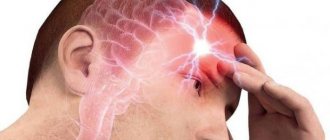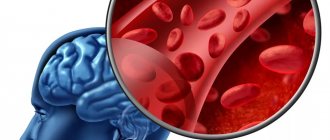Classification of autonomic disorders
Depending on the intensity, origin, and nature of autonomic disorders, several subgroups of VSD are distinguished.
Depending on the cause, psychogenic, hereditary, infectious and dyshormonal forms of vegetative-vascular dystonia are distinguished; in some cases, children have a mixed type of VSD, which is characterized by a combination of several causes of symptoms.
According to the nature of the disorders, the syndrome is:
- sympathicotonic, when the disorder is expressed in restless, overly emotional and even aggressive behavior;
- vagotonic, which manifests itself in the form of chills, increased or decreased body temperature, dizziness, sensation of a foreign body in the throat;
- combined, when there is no clear predominance of certain symptoms.
There are also systemic, local and generalized forms of pathology according to the degree of prevalence of disorders. According to the severity of VSD disorders, there are mild, moderate and severe forms.
Article “Vegetative-vascular dystonia in children.”
Rheumatologist d/p No. 6 Kudryashova Elena Aleksandrovna.
VSD is perhaps one of the most mysterious abbreviations in medicine. Many people have probably heard about it, but not everyone will undertake to explain what it is and how it manifests itself.
Where does dystonia come from?
According to various studies, VSD occurs to varying degrees in children of primary school age.
The manifestations of dystonia are different, but the causes can most often be linked into one large group - psychological problems:
- acute and chronic stress;
- new living conditions (change of school, divorce of parents, appearance of another child in the family);
- conflicts in the children's team or in the family;
- physical and mental overload.
Predisposing factors for the next “attack” of VSD manifestations can be:
- weather changes;
- sedentary lifestyle (especially sitting in front of a computer or TV);
- violation of the daily routine, especially lack of sleep and proper rest;
- poor nutrition;
- changes in hormonal levels during puberty.
How does VSD manifest itself?
As mentioned above, VSD is a complex of symptoms based on various diseases and pathologies. This is why dystonia has a huge number of symptoms; let’s try to list the main ones.
Nervous systems and heart
As a rule, one of the most common manifestations of vegetative-vascular dystonia are headaches, attacks of increased heart rate and dizziness. Sleep disturbances are often observed, and this can be either insomnia or, conversely, increased drowsiness.
Another characteristic sign is deep breaths, as if the child is not getting enough air. Some children even develop shortness of breath.
Stomach problems
Children suffering from VSD often suffer from abdominal pain and complain of nausea and bloating. The so-called “bear disease” often manifests itself - diarrhea that occurs during stress, anxiety, and fear.
Urinary disorders
With VSD, the bladder suffers very often, and the manifestations can be directly opposite to each other. Children either begin to run to the toilet frequently, or, conversely, urinate rarely and in large portions.
Thermoregulation
Unreasonable jumps in temperature may be observed - during the day it rises to 37-37.5 degrees, and at night it returns to normal, while there are no signs of inflammation, and blood and urine tests are normal.
Emotional background
Children with VSD may experience frequent mood swings and causeless fears and anxieties. Parents may notice apathy, lethargy, and lack of interest in games and communication with loved ones. Often the opposite situation occurs - the child becomes hyperexcited and capricious.
Crises
In addition to the usual symptoms, vegetative-vascular dystonia is characterized by special conditions - so-called crises or panic attacks. They represent an acute attack of anxiety and inexplicable fear, accompanied by a feeling of lack of air and rapid heartbeat. The child feels hot and cold, sweats profusely and complains of dizziness. A characteristic symptom is a strong fear of death; it is not for nothing that the attack is called a “panic attack.”
Diagnosis of VSD
Diagnosing vegetative-vascular dystonia is a difficult task even for an experienced doctor, because the variety of manifestations requires the involvement of various specialists - from a neurologist to a psychiatrist, as well as a number of laboratory and instrumental studies.
Treatment of VSD
Therapy for vegetative-vascular dystonia is always complex and long-term. Doctors examining the child give recommendations and, if necessary, prescribe medications.
However, the most important thing with VSD is compliance with certain rules:
- the correct daily routine is very important, and, most importantly, a sufficient amount of sleep and rest - children are supposed to sleep at least 8-10 hours;
— correct alternation of mental activity and physical activity;
- daily active walks in the fresh air.
It is important that in the life of every child, in the absence of contraindications, of course, there is physical education. This could be dancing, swimming, badminton or wrestling, the main thing is that the classes are regular.
Proper nutrition also plays a big role - you need to avoid excessive consumption of salt, fatty and fried foods, chocolate, cola and cocoa.
It is very important to protect the child from stress as much as possible - create a favorable climate in the family, help the child solve problems in communicating with classmates and friends, and, if necessary, involve a child psychologist.
Thus, VSD is not an easy task, both for the doctor and for the parents, and only a coordinated and comprehensive approach can alleviate the child’s condition as much as possible and help him cope with attacks of dystonia.
Symptoms
Manifestations of vegetative-vascular dystonia in children and adolescents are diverse and diverse; in fact, any symptoms of deterioration in general physical and psycho-emotional well-being can fit under this concept. In total, about 30 different syndromes have been described based on more than 150 complaints.
Basically, symptoms of VSD in children and adolescents include disorders of the central nervous system, cardiovascular system, respiratory system, and gastrointestinal tract. The most common signs were:
- increased fatigue;
- sleep disorders;
- dizziness;
- cardiopalmus;
- arrhythmia;
- changes in blood pressure;
- headache;
- diarrhea;
- feeling of lack of air;
- increased body temperature without signs of infection;
- change in pupil size;
- muscle and joint pain;
- chills;
- hand tremors;
- increased sweating;
- cold extremities;
- pain in the heart area.
In adolescence, in boys and girls, VSD often manifests itself as increased anxiety, unreasonable fears, and sudden changes in mood. In some cases, parents note excessive emotionality, violent expression of feelings, and sometimes unmotivated aggression and anger.
Syndromes of vegetative-vascular dystonia (VSD) in children, symptoms of VSD
With vegetative-vascular dystonia (VSD), various clinical syndromes are observed.
Cardiac vegetative vascular dystonia syndrome (VSD)
Cardiac syndrome of vegetative-vascular dystonia (VSD) is manifested by sensory (cardialgia) and motor (rhythm disturbances) disorders of the heart. Cardiovascular pain is moderate, but fear and overestimation of its significance give it an overvalued character. Sometimes paroxysmal cardialgia is observed. Heart rhythm disturbances include sinus tachycardia, arrhythmia, bradycardia, and irregular extrasystole. Disorders of regulation of vascular tone and associated hemodynamic disorders are characteristic. High blood pressure in children is considered to be more than 120/65 mmHg. Art. at the age of 11-14 years, and 130/70 mm Hg. Art. in adolescents aged 15-18 years.
In children and adolescents, in 70% of cases, hypertensive conditions are observed: fatigue, heart pain, headaches, dizziness, sweating, chilliness, feeling of lack of air, sleep disturbances. VSD of the hypotonic type occurs early, but manifests itself during puberty. It is characterized by a combined decrease in systolic and diastolic pressure below 90/60 mmHg. Art., asthenic physique, retardation in physical and psychomotor development, fatigue, headaches, dizziness when changing position, poor tolerance of transport or heights, vestibulopathy, discomfort in the heart area, sometimes fainting and migraine are observed.
Respiratory syndrome of vegetative vascular dystonia (VSD)
Respiratory syndrome of vegetative-vascular dystonia (VSD) is manifested by shortness of breath at rest and during physical stress, and a feeling of lack of air. Children take deep, noisy breaths, which causes hyperventilation and alkalosis.
Syndrome of impaired thermoregulation with vegetative vascular dystonia (VSD)
The syndrome of impaired thermoregulation with vegetative-vascular dystonia (VSD) is initially periodic in nature - after an infection, a low-grade fever persists for about 15 days. Over time, the duration of periods of low-grade fever lengthens and persistent non-infectious low-grade fever develops with a temperature of 37.5 to 37.5 degrees Celsius against the background of normal clinical and biochemical tests. Body weight remains normal. In adolescence, the syndrome can manifest itself in the form of temperature crises confined to a specific cycle (time of day, week, month) or environment (school classes). Temperature rises to 39 degrees and above are accompanied by chills, lasting from 30 to 120 minutes. Febrile crises are easily tolerated, despite their high frequency.
Vegetative vascular crises - hypothalamic, cerebral crises, panic attacks, crises
Autonomic-vascular crises (hypothalamic, cerebral crises, “panic” attacks) are sympathoadrenal, vaginsular and mixed.
A sympathoadrenal crisis is manifested by headache and cardialgia, palpitations, a feeling of fear, and numbness of the limbs. Tachycardia, increased blood pressure, body temperature, blood glucose levels, and pale skin are observed. At the height of the attack, chills are noted, at the end - the urge to urinate, polyuria, after the attack - severe asthenia.
Vagoinsular (parasympathetic) crisis is characterized by a sinking heart, a feeling of lack of air, dizziness, and unpleasant sensations in the abdomen. Hyperemia of the skin, sweating, bradycardia, a moderate decrease in blood pressure, a feeling of fear, and post-crisis asthenia are expressed.
A mixed crisis is manifested by the features of sympatho- and vagotonia, which occur simultaneously or sequentially. Vegetative-vascular crises are rare in children. Their direction is often vagotonic.
Neurotic syndrome of vegetative vascular dystonia (VSD)
Neurotic syndrome of vegetative-vascular dystonia is one of the permanent symptom complexes of VSD of the brain, which manifests itself several weeks or months after the onset of the disease and increases over time. The general neurotic syndrome in children rarely reaches great severity; decreased mood, sleep disturbances, anxious suspiciousness, emotional lability, phobias, sometimes demonstrative behavior, and hysterical manifestations are noted.
Reasons for the development of the syndrome
As well as signs, there are many reasons for the occurrence of vegetative-vascular dystonia in childhood.
In some cases, the pathology is hereditary in nature and is caused by congenital dysfunctions of the autonomic system. As a rule, such deviations are passed on to the child through the mother. In each specific case, for effective treatment of VSD in adolescents and children, it is necessary to reliably identify the primary disease or complex of pathologies that caused autonomic disorders. The most common reasons were:
- diseases of the central nervous system;
- a sharp change in hormonal levels;
- allergic pathologies;
- acute and chronic infections;
- features of maturation and development of the child’s autonomic system;
- pathologies of the endocrine system;
- head and neck injuries;
- vascular diseases.
In adolescence, smoking, including passive smoking, can cause deterioration in the functioning of the autonomic system. Often the mechanism of VSD is triggered by stress, mental and physical strain, violent quarrels with loud expressions of feelings.
In preschoolers and primary school students, disorders can be triggered by excessive workload, unfavorable environmental background, diseases suffered during fetal development or in early childhood.
At what age will prevention be effective?
It is logical to assume that early prevention of VSD will be most effective, and this is true. But the more important factor is the consistency of preventive measures. If prevention is started at an early age, but not regularly, you can even achieve the opposite effect - provoke the early onset of VSD.
A child is most vulnerable during an age-related or any other crisis. At this time, it is important to pay special attention to preventive measures.
If there is a family tendency to autonomic dysfunction, it is necessary to start preventing VSD at least 10 years old, if it has not been done before. This will make it both physiologically and psychologically easier to survive adolescence.
Diagnosis of VSD
The initial stage of the examination is the collection of a detailed medical history. The doctor needs to know almost everything about the little patient:
- age;
- features of intrauterine development, birth and the first years of life;
- past illnesses and surgeries;
- frequency of diseases per year;
- completed treatment;
- environmental situation in the place of residence.
The specialist needs to painstakingly collect all available information, including observations of parents, complaints of the child himself, and lifestyle features.
After collecting an anamnesis, a general examination is carried out, during which the doctor assesses the condition of the skin, mucous membranes of the nose and oral cavity, lymph nodes and other visible structures.
The next stage of diagnosis is laboratory and instrumental examination methods. Depending on the direction of symptoms and complaints, the following are performed:
- a set of laboratory tests of blood and urine;
- Ultrasound;
- MRI or CT;
- breath tests;
- allergy tests;
- EchoCG and ECG;
- electroencephalography;
- fluoroscopy.
Additionally, the attending physician can refer the child to a consultation with an ophthalmologist, surgeon, urologist, gynecologist, or otolaryngologist.
Treatment of vegetative-vascular dystonia in children
Treatment of VSD in children involves, first of all, relieving unpleasant symptoms and searching for the pathology that provoked the syndrome. A set of treatment methods is selected depending on the nature of the disorders and may include:
- various physiotherapeutic procedures;
- massage;
- various breathing exercises;
- physical therapy course;
- drug support.
It is highly desirable to correct the lifestyle of children with signs of vegetative-vascular dystonia. To reduce negative manifestations and prevent further worsening of the syndrome, children and adolescents need to:
- sleep at least 8 hours a day;
- maintain a daily routine;
- eat properly and balanced;
- undergo regular preventive examinations;
- do physical education.
Parents need to provide a comfortable and friendly environment at home, provide psychological support to their children, and promptly and adequately treat infectious diseases and injuries. Treatment of the disease can only be prescribed by a doctor; self-medication is strictly prohibited.
Prevention
For prevention, the doctor may recommend:
- long night sleep - at least 8 hours;
- adherence to daily routine;
- limiting time on the computer and TV to 30-60 minutes a day;
- daily walks in the air from half an hour to 2 hours, depending on the age and condition of the child;
- balanced diet with fresh fruits and vegetables;
- sports: volleyball, swimming, skating and other types of active physical activity;
- reducing stress, reducing stressful situations.
Vegetative-vascular dystonia in children is easy to correct. But self-prescribing medications will only worsen the body’s condition. Don't risk your child's health! Neurologists at Iris MC will prescribe treatment based on the results of the examination, taking into account the individual characteristics of the patient. Only this approach can successfully cope with the disease.
Prevention of VSD
General strengthening measures, timely vaccination, and prevention of potential risk factors will help prevent the occurrence of vegetative-vascular dystonia in childhood and adolescence. Experts recommend not overloading young children with excessive activities, and providing teenagers with comprehensive assistance in their studies and creativity.
It is important to closely monitor the child’s health, not to try untested or questionable methods in the child’s therapy, and not to give narrow-spectrum drugs as self-medication.
If you suspect VSD, contact a professional: our specialists will find the cause of autonomic disorders, select an individual treatment regimen and corrective techniques, taking into account all the characteristics of your child.
What is vegetative-vascular dystonia VSD, NCD?
Vegetative-vascular dystonia, vegetative-vascular dystonia (VSD , NCD, neurocirculatory dystonia) is a selective disorder of visceral functions caused by a violation of their regulation. Synonyms for vegetative-vascular dystonia are VSD , NCD , autonomic dysfunction, vegetative-vascular dystonia, autonomic neurosis, vegetative-vascular dystonia, neurocirculatory dystonia, vegetative-vascular form of hypothalamic syndrome, psycho-vegetative syndrome, vegetative-vascular dystonia . VSD can be considered as a secondary syndrome, manifested in neuroses, organic diseases of the nervous system, internal organs, and endocrine glands. In childhood, the incidence of VSD is from 10 to 50%.








